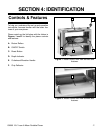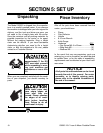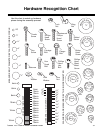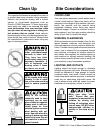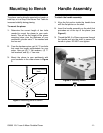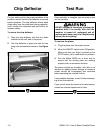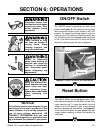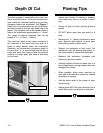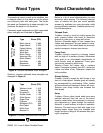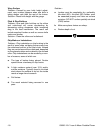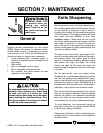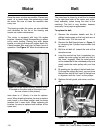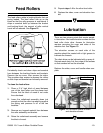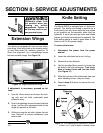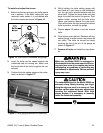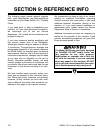
G0505 12
1
⁄2" Lean & Mean Portable Planer
-15-
Figure 8. Common hardwood shear strengths.
The species of wood, as well as its condition, has
a dramatic effect on the depth of cut the planer
can effectively take with each pass. The harder
the wood (as illustrated by its shear strength), the
shallower the depth of cut should be.
Commonly used hardwoods and their associated
shear strengths are illustrated in Figure 8.
Similarly, common softwood shear strengths are
displayed in Figure 9.
Wood Types
Type Shear (PSI)
Black Locust 2,480
Sugar Maple 2,330
Pecan Hickory 2,080
White Oak 2,000
White Ash 1,950
Black Cherry 1,700
American Elm 1,510
Black Walnut 1,370
Red Alder 1,080
Basswood 980
Cottonwood 930
Increasing
Difficulty
Figure 9. Common softwood shear strengths.
Type Shear (PSI)
Western Larch 1,410
Tamarack 1,280
Douglas Fir 1,160
Alaska Cedar 1,130
Sitka Spruce 1,150
Sugar Pine 1,050
Cypress 1,000
Redwood (OG) 940
Red Cedar 860
White Pine 850
Balsam Fir 710
Increasing
Difficulty
Wood Characteristics
Below is a list of wood characteristics you may
encounter when planing. The following descrip-
tions of defects will give you some possible
answers to problems you may encounter while
planing different materials. Possible solutions fol-
low the descriptions.
Chipped Grain
Problem—Usually a result of cutting against the
grain, planing lumber with knots or excessive
amount of cross grain, or using dull knives.
Solution—Decrease depth of cuts. Inspect your
lumber and determine if its grain pattern is caus-
ing the problem. If the lumber does not show sub-
stantial crossgrain, sharpen your knives.
Fuzzy Grain
Problem—Usually caused by surfacing lumber
with too high of a moisture content. Sometimes
fuzzy grain is an unavoidable characteristic of
some woods, such as basswood. Fuzzy grain
can also be caused by dull knives.
Solution—Check the lumber with a moisture
meter. If moisture is greater than 20%, sticker the
lumber and allow to dry. Otherwise, inspect the
knife condition.
Glossy Surface
Problem—Usually caused by dull knives or too
slow of a feed speed. Surface gloss will usually
be accompanied by overheating. Often, lumber
will be scorched and damage to knives will occur.
Solution—Use sharp knives and increase the
feed speed.
Snipe
Problem—Occurs when board ends have more
material removed than the rest of the board.
Usually caused when the workpiece is not prop-
erly supported as it goes through the machine.
However, a small amount of snipe is inevitable.
Solution—The best way to deal with snipe is by
planing lumber longer than your intended work
length and then cutting off the excess after plan-
ing is completed.



